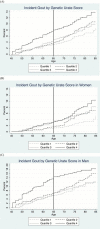Gout in Older Adults: The Atherosclerosis Risk in Communities Study
- PMID: 26714568
- PMCID: PMC5014186
- DOI: 10.1093/gerona/glv120
Gout in Older Adults: The Atherosclerosis Risk in Communities Study
Abstract
Background: It is unclear whether traditional and genetic risk factors in middle age predict the onset of gout in older age.
Methods: We studied the incidence of gout in older adults using the Atherosclerosis Risk in Communities study, a prospective U.S. population-based cohort of middle-aged adults enrolled between 1987 and 1989 with ongoing follow-up. A genetic urate score was formed from common urate-associated single nucleotide polymorphisms for eight genes. The adjusted hazard ratio and 95% confidence interval of incident gout by traditional and genetic risk factors in middle age were estimated using a Cox proportional hazards model.
Results: The cumulative incidence from middle age to age 65 was 8.6% in men and 2.5% in women; by age 75 the cumulative incidence was 11.8% and 5.0%. In middle age, increased adiposity, beer intake, protein intake, smoking status, hypertension, diuretic use, and kidney function (but not sex) were associated with an increased gout risk in older age. In addition, a 100 µmol/L increase in genetic urate score was associated with a 3.29-fold (95% confidence interval: 1.63-6.63) increased gout risk in older age.
Conclusions: These findings suggest that traditional and genetic risk factors in middle age may be useful for identifying those at risk of gout in older age.
Keywords: Gout; Urate genetics.
© The Author 2015. Published by Oxford University Press on behalf of The Gerontological Society of America. All rights reserved. For permissions, please e-mail: journals.permissions@oup.com.
Figures


Similar articles
-
[The epidemiology and genetic of gout].Presse Med. 2011 Sep;40(9 Pt 1):830-5. doi: 10.1016/j.lpm.2011.04.012. Epub 2011 Jul 12. Presse Med. 2011. PMID: 21752574 Review. French.
-
A urate gene-by-diuretic interaction and gout risk in participants with hypertension: results from the ARIC study.Ann Rheum Dis. 2013 May;72(5):701-6. doi: 10.1136/annrheumdis-2011-201186. Epub 2012 Jun 29. Ann Rheum Dis. 2013. PMID: 22753387 Free PMC article.
-
Genetics of gout.Curr Opin Rheumatol. 2010 Mar;22(2):144-51. doi: 10.1097/BOR.0b013e32833645e8. Curr Opin Rheumatol. 2010. PMID: 20110790 Review.
-
An update on the genetic architecture of hyperuricemia and gout.Arthritis Res Ther. 2015 Apr 10;17(1):98. doi: 10.1186/s13075-015-0609-2. Arthritis Res Ther. 2015. PMID: 25889045 Free PMC article. Review.
-
The genetic basis of hyperuricaemia and gout.Joint Bone Spine. 2011 Jan;78(1):35-40. doi: 10.1016/j.jbspin.2010.02.027. Epub 2010 May 15. Joint Bone Spine. 2011. PMID: 20472486 Review.
Cited by
-
Association between smoking and gout: a meta-analysis.Clin Rheumatol. 2018 Jul;37(7):1895-1902. doi: 10.1007/s10067-018-4118-y. Epub 2018 Apr 26. Clin Rheumatol. 2018. PMID: 29696438 Review.
-
Gout Arthritis During Admission for Decompensated Heart Failure-A Descriptive Analysis of Risk Factors, Treatment and Prognosis.Front Med (Lausanne). 2022 Feb 14;9:789414. doi: 10.3389/fmed.2022.789414. eCollection 2022. Front Med (Lausanne). 2022. PMID: 35237621 Free PMC article.
-
Global, regional, and national burden of gout among older adults (≥65) from 1990 to 2021 and projections for 2050.Front Public Health. 2025 Jun 16;13:1540190. doi: 10.3389/fpubh.2025.1540190. eCollection 2025. Front Public Health. 2025. PMID: 40589811 Free PMC article.
-
Second-Hand Smoke and Its Synergistic Effect with a Body-Mass Index of >24.9 kg/m2 Increase the Risk of Gout Arthritis in Indonesia.Int J Environ Res Public Health. 2021 Apr 19;18(8):4324. doi: 10.3390/ijerph18084324. Int J Environ Res Public Health. 2021. PMID: 33921811 Free PMC article.
-
Physical Function, Hyperuricemia, and Gout in Older Adults.Arthritis Care Res (Hoboken). 2015 Dec;67(12):1730-8. doi: 10.1002/acr.22648. Arthritis Care Res (Hoboken). 2015. PMID: 26138016 Free PMC article.
References
-
- Zhu Y, Pandya BJ, Choi HK. Prevalence of gout and hyperuricemia in the US general population: the National Health and Nutrition Examination Survey 2007–2008. Arthritis Rheum. 2011;63:3136–3141. doi:10.1002/art.30520 - PubMed
-
- Zhu Y, Pandya BJ, Choi HK. Comorbidities of gout and hyperuricemia in the US general population: NHANES 2007–2008. Am J Med. 2012;125:679–687 e671. doi:10.1016/j.amjmed.2011.09.033 - PubMed
-
- Wallace KL, Riedel AA, Joseph-Ridge N, Wortmann R. Increasing prevalence of gout and hyperuricemia over 10 years among older adults in a managed care population. J Rheumatol. 2004;31:1582–1587. - PubMed
-
- De Leonardis F, Govoni M, Colina M, Bruschi M, Trotta F. Elderly-onset gout: a review. Rheumatol Int. 2007;28:1–6. - PubMed
Publication types
MeSH terms
Substances
Grants and funding
LinkOut - more resources
Full Text Sources
Other Literature Sources
Medical

